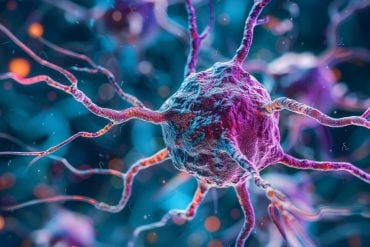Summary: Cannabigerol (CBG), a non-psychoactive cannabis compound, has antibiotic potential. Treating mice with MRSA, CBG worked as well as vancomycin, a powerful antibiotic, for treating the infection.
Source: American Chemical Society
Public health agencies worldwide have identified antibiotic resistance of disease-causing bacteria as one of humanity’s most critical challenges. However, scientists haven’t discovered a new class of antibiotics in more than 30 years. Now, researchers reporting in ACS Infectious Diseases have uncovered the hidden antibiotic potential of a non-psychoactive cannabis compound called cannabigerol (CBG), which helped control methicillin-resistant Staphylococcus aureus (MRSA) infections in mice.
For centuries, cannabis plants have been used in folk medicine. Today, scientists are only beginning to investigate whether different cannabis compounds could be used to treat a variety of diseases. Early studies have shown that some cannabinoids can slow the growth of gram-positive bacteria, such as S. aureus, but not gram-negative bacteria, such as E. coli. Eric Brown and colleagues wanted to test the antibacterial properties of several cannabinoids against both MRSA and gram-negative bacteria.
The researchers tested the antibacterial activity of 18 cannabis-derived molecules, including cannabidiol (CBD), tetrahydrocannabinol (THC) and CBG, against MRSA. They also tested the ability of these substances to prevent the formation of biofilms on surfaces and to kill dormant “persistor” MRSA that are highly resistant to antibiotics. CBG performed the best in these tests, so the researchers chose to study it further.
When they treated MRSA-infected mice with CBG, the compound worked as well as vancomycin, a powerful antibiotic. The researchers discovered that CBG targets the cell membrane of gram-positive bacteria, and by itself, it is not effective against gram-negative bacteria, which have an additional outer membrane.

However, they found that if they gave CBG with another drug that pokes holes in this outer membrane, CBG could reach the inner membrane and kill gram-negative bacteria.
Funding: The authors acknowledge funding from the Canada Research Chairs program, the Canadian Institutes of Health Research Foundation Grant Program and the Michael G. DeGroote Centre for Medicinal Cannabis Research.
Source:
American Chemical Society
Media Contacts:
Katie Cottingham – American Chemical Society
Image Source:
The image is in the public domain.
Original Research: Closed access
“Uncovering the Hidden Antibiotic Potential of Cannabis”. Maya A. Farha, Omar M. El-Halfawy, Robert T. Gale, Craig R. MacNair, Lindsey A. Carfrae, Xiong Zhang, Nicholas G. Jentsch, Jakob Magolan, Eric D. Brown.
ACS Infectious Diseases doi:10.1021/acsinfecdis.9b00419.
Abstract
Uncovering the Hidden Antibiotic Potential of Cannabis
The spread of antimicrobial resistance continues to be a priority health concern worldwide, necessitating the exploration of alternative therapies. Cannabis sativa has long been known to contain antibacterial cannabinoids, but their potential to address antibiotic resistance has only been superficially investigated. Here, we show that cannabinoids exhibit antibacterial activity against methicillin-resistant Staphylococcus aureus (MRSA), inhibit its ability to form biofilms, and eradicate preformed biofilms and stationary phase cells persistent to antibiotics. We show that the mechanism of action of cannabigerol is through targeting the cytoplasmic membrane of Gram-positive bacteria and demonstrate in vivo efficacy of cannabigerol in a murine systemic infection model caused by MRSA. We also show that cannabinoids are effective against Gram-negative organisms whose outer membrane is permeabilized, where cannabigerol acts on the inner membrane. Finally, we demonstrate that cannabinoids work in combination with polymyxin B against multidrug resistant Gram-negative pathogens, revealing the broad-spectrum therapeutic potential for cannabinoids.







